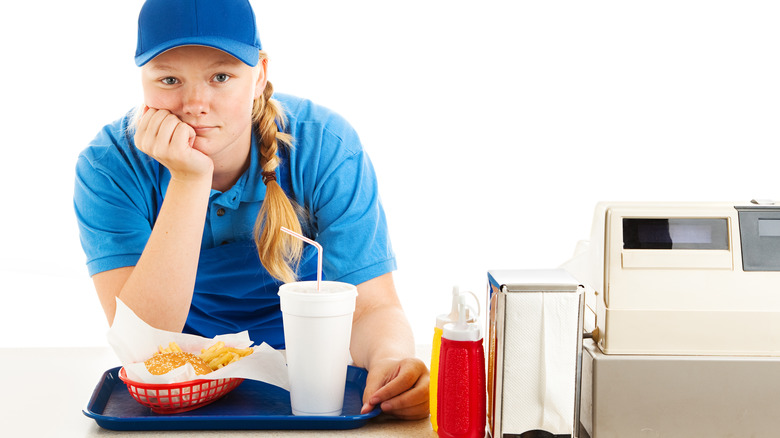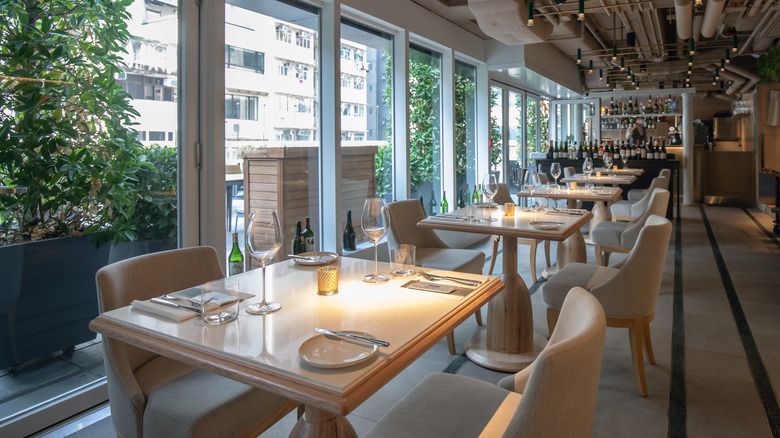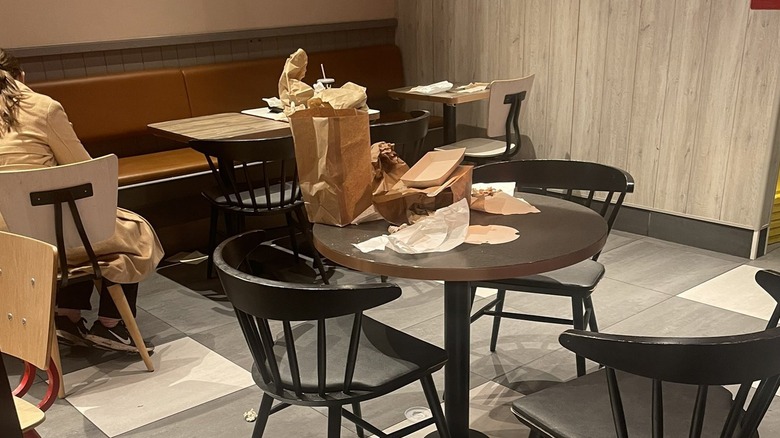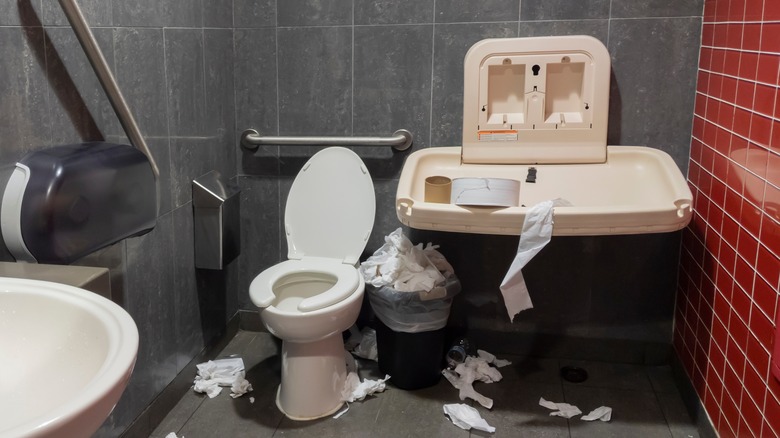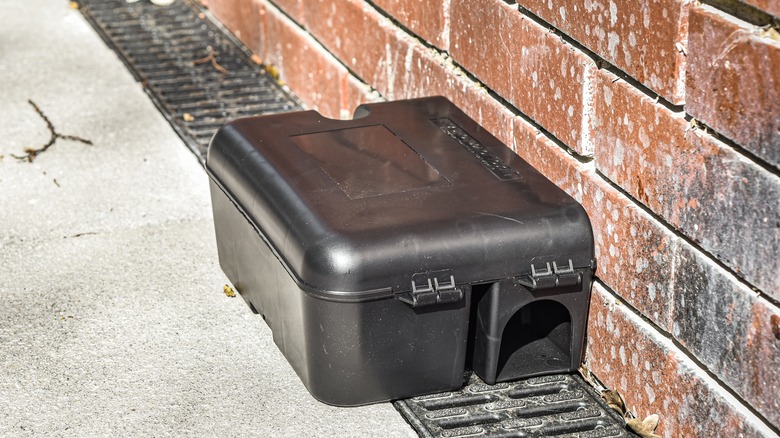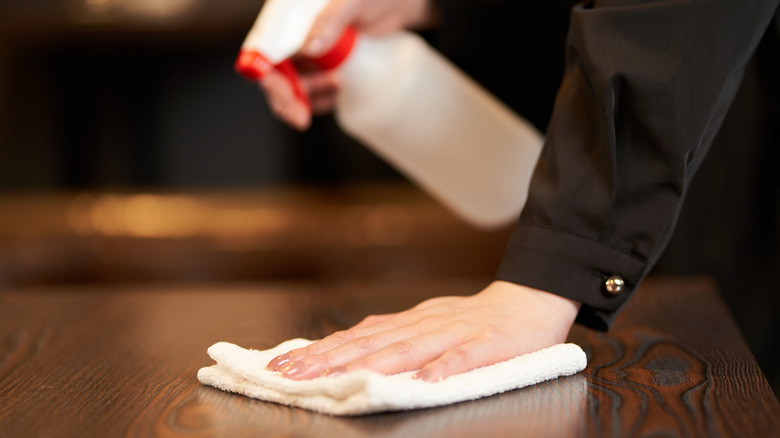12 Restaurant Red Flags You'll Wish You Watched Out For
Is there any experience more revered in modern culture than eating out at a restaurant? There may not be — particularly in light of the still-fresh scars caused by indoor dining restrictions during the seemingly endless COVID-19 pandemic. Frankly, after losing months (or years) of in-person dining opportunities, a number of U.S. consumers were likely willing to throw caution to the wind upon returning to restaurants.
But the excitement generated by the prospect of dining out shouldn't blind you to potential warning signs, or cause you to unintentionally overlook red flags when choosing where to eat. Not all restaurants or dining experiences are created equal, after all. And while we're not implying perfection is the bare minimum we're willing to accept from an establishment, expecting a restaurant we patronize to meet a certain set of standards isn't too much to ask.
Since you don't necessarily know what you'll encounter beforehand when choosing a restaurant to go to, it's best to be prepared for any and all situations (like a good Boy Scout would). On that note, we've compiled a handy list of potential warning signs to consider when choosing where to eat. Whether it's issues with the establishment and building itself, or inferences based on a staff's behavior, here are 12 restaurant red flags you'll wish you looked out for ahead of your visit.
The servers have little to no knowledge of a restaurant's menu
To be perfectly clear, when we say we expect a restaurant's servers to be knowledgeable of the menu, we're not saying they need to be as well-versed as a preacher with the Bible. Still, we think it's rather obvious why servers, waiters, and waitresses need to be at least moderately familiar with the menu items offered by their employer — and easy to see why you should take it as a red flag if they aren't.
For starters, there's a better than average chance you or your fellow diners may have a question or two about certain dishes before ordering. Of course, if a server exhibits an in-depth knowledge of the menu, it helps demonstrate that restaurant's commitment to quality and customer satisfaction, according to Chef Works. But if a server can't answer a simple menu query, why should the customer trust any other area of the restaurant to deliver on its promise?
Quite frankly, according to State Food Safety, nothing may irritate a customer more than an oblivious server. We concur with this line of thinking, and can only hope you'll heed our advice: If the servers know little-to-nothing about the menu, you'll want to consider a different dinner spot.
The menu is excessive in length and available options
We've always found the idea that "a jack of all trades is a master of none" to be fairly accurate. Sure, there may be an incredibly small handful of spectacularly talented and skilled individuals who are genuinely, well, spectacular in multiple areas or fields. But realistically, a good rule of thumb when choosing an expert in some manner is the more they do, the less likely they are to be great at any one thing — like restaurants with monumentally long menus.
While long-time conventional wisdom often suggested consumers wanted more choices from restaurants, according to the Washington Post, that seemed to have changed during the 2010s. For one thing, an enormous number of menu options seemed to bog down many restaurants' efficiency levels, leading to longer wait times for customers. But as McDonald's chief operating officer Tim Fenton told the Washington Post in 2014, the best strategy for efficiency of service included "fewer products with better execution" — i.e., avoiding an excessive number of menu options.
Frankly, a smaller menu helps "simplify operations...for team members," as Denny's chief brand officer John Dillon told CNN in 2020. So, if you're eager to ensure you'll get quality food prepared in a timely manner, avoid those restaurants with far too many choices.
A seafood restaurant that smells like fish
We'd be willing to bet very few scents are more universally known than fish — for better or worse. Frankly, even fans of aquatic-based proteins may find seafood's briny smell off-putting and oppressive to their senses, particularly when it trends towards the overwhelming, ammonia-like territory of rotting fish. Of course, fresh fish is sort of bizarre in the sense that it shouldn't smell particularly, well, fishy. So if the first thing you notice when entering a seafood-based restaurant is the smell of fish, you may want to hightail it out of there.
Now, the smell of fish at a restaurant doesn't mean every piece of seafood is inedible or unsafe for consumption. But, as noted on Quora, when the scent is overwhelmingly fishy, there's a decent chance the seafood in question has taken a turn for the worse. In fact, according to the Los Angeles Times, fresh seafood shouldn't smell fishy at all, but more fresh and clean.
Frankly, there's something fishy about a seafood restaurant that smells aggressively like fish. If you detect anything even slightly off about the odor, follow that red flag's caution, and choose another establishment.
The restaurant staff appears disinterested or disgruntled to customers
There may be no better indication of a business or company's general structure than the morale of its employees. We don't mean that a company's employees should be overly joyful or energetic at all times, since the human brain doesn't work that way (via Psychology Today). But if a restaurant's staff appears outwardly bored or unhappy from the moment you enter a restaurant, it may not be worth your time or money.
Now, in recent years, a number of food service workers' displeasure may be attributed to lingering staff shortages and unreasonably rude customers post-COVID-19 (via CNN). But even before the coronavirus changed the world in 2020, the sight of displeased restaurant staff was often a red flag for general restaurant dysfunction. Perhaps a restaurant's management displays a general lack of concern for its staff and their lives — with a poorly-managed schedule, for instance (via Toast) — which, in turn, leads to unhappy staff and a subpar experience for the customer.
We certainly understand restaurant staff are human beings just like the rest of us, and won't always be thrilled to be at work. But if you notice a restaurant's employees displaying clear signs of unhappiness, like clock-watching or refusing to engage with other staff and customers (via Upserve), don't waste your time or money.
A restaurant that's empty regardless of location or time of day
Considering many of us are eager to find hidden gems in the world, an empty restaurant may prompt a person to give a less-patronized spot a shot. And, to be sure, there's a number of potential reasons why a restaurant may appear empty to the outside eye, but is in fact doing just fine business-wise (via Quora). Still, when you're looking for a place to dine outside of home, it may be best to hone in on a restaurant where actual customers are seen enjoying their meals.
Again, we're not trying to say an empty restaurant will be empty solely because it provides a substandard dining experience to customers. After all, according to the Pittsburgh Post-Gazette, a seemingly unpopulated restaurant may do more takeout than in-person business, or may simply be busy at different times of the day or week than when you visit.
Yet, we can't shake the feeling that if there's no one patronizing a restaurant you're considering eating at, there's a decent chance something's amiss inside. Are we being unfair? Perhaps, but we stand by our decision. If a restaurant's empty when it seems like it should be busy, try a different location.
A 'fresh catch of the day' is sold when no body of water exists within 100 miles
Like any business based on customer sales, a restaurant may embellish at times when it comes to its offerings — think the "world's best cup of coffee" found by Buddy (Will Ferrell) in "Elf." Along those same lines, a restaurant may stretch the truth on occasion when it comes to the source of its menu items. And while many of these instances are essentially harmless, some stand out as red flags, like a restaurant that features a fresh caught daily fish special — despite having no body of water within a two-hour drive.
Now, some on Quora believe there's little reason to trust the veracity of a restaurant's so-called fresh-caught fish special unless you can actually see water. We wouldn't go so far as to say you need to be literally dockside to trust your fish was caught that same day — even though we're clearly less-than-thrilled at the notion of consuming any seafood items falsely advertised as fresh caught.
Of course, while there's no doubt an advertised 'fresh catch of the day' from a severely landlocked restaurant is sketchy, the issue is more about quality than safety. After all, previously-frozen fish isn't inherently dangerous for consumption ... but it can become unbearably mushy if not properly handled. And who wants to spend their hard-earned money on a soggy piece of fish?
The restaurant's appears excessively dirty inside and out
As we mentioned at the beginning, we're not here to demand perfection across the board from a restaurant. But when it comes to a restaurant's cleanliness, well, is it really expecting a lot for the building to be fairly clean and well-maintained for the customer's benefit? After all, if we wanted to eat in an unkempt area, we could simply stay home and cook (on those days we don't feel like cleaning). Frankly, then, if the exterior of a restaurant is filthy, or there's dirt, grease, or food crumbs scattered around the inside? Don't give it your business.
There are several tell-tale signs that a restaurant may be far too filthy for you to visit. According to Medical News, this includes an excess amount of trash or garbage outside, a potentially overbearing stench of mildewy water inside, or sticky tables (ewwww!).
We recognize the immensely long list of areas and items to clean at a restaurant can be daunting (via FSR). But if you can't stand the heat, you need to get out of the kitchen. And if a restaurant can't get its act together enough to remain clean and well-maintained for customers, you shouldn't give it your business.
The menus never leave the table
In 2023, we can probably spare you a long-winded explanation about the dangers of germs, bacteria, and viruses lingering on uncleaned surfaces (COVID-19, anyone?). And while our hands may not be the germiest part of the human body — spoiler: it's the belly button — there's no doubt we harbor a ton of potentially harmful microscopic organisms on our hands. So if a restaurant's menus never leave the table, they aren't likely to be very clean — meaning it may not be worth the health risk to dine there.
Menus are one of the most germ-ridden items in a restaurant (via Today), largely because of the numerous pairs of hands touching said menu daily. Of course, this becomes particularly problematic with menus that never leave the table. Sure, restaurant staff are likely supposed to wipe down plastic menus between customers, but the hectic pace of restaurants means many staff may forgo this step in order to facilitate turnover.
Since restaurant menus can be disgustingly filthy one way or another, it may be worth the time to find out how often a restaurant's menus are actually cleaned. And while it may be somewhat unfair to assume a menu that never leaves the table is always too dirty to touch, we generally prefer to err on the side of caution — at least when it comes to our health.
The bathrooms are filthy
Have you ever entered a truly repulsive public restroom? We'll assume the answer is yes, because you're a human being living in the world in 2023. Now, we can't say our own bathroom is always sparkling ... but at the same time, we're not hosting (paying) guests on a regular basis for dinner. So if a restaurant's bathroom is absolutely disgusting — regardless of the rest of the establishment — you may be wise to take that red flag at face value.
After all, according to WebMD, a person can become infested with any number of potentially harmful germs or bacteria in a dirty bathroom. Additionally, there's just something so incredibly unpleasant about discovering a repugnant, filth-ridden bathroom at a restaurant — and we're not alone in this assessment, either.
In fact, according to a 2016 Harris Interactive survey (via USA Today), a fairly substantial 3 out of 10 consumers would never return to a restaurant if the bathrooms weren't clean. Clearly, then, you can add us to the 'never-return' crowd — and, if you don't want to come across any unexpected restaurant bathroom discoveries yourself, you should join us there, too.
Rodent or pest traps are scattered around the building (outside or indoors)
Look, we're not unreasonable people by any stretch of the imagination. We fully understand the entire premise of restaurants and food-based businesses are a natural attraction for pests of all sorts. Still, when you consider the number of health, safety, and logistical issues presented by a rodent infestation at a restaurant (via Canadian Institute of Food Safety), if you notice a number of bait stations or rodent traps in and around a restaurant? You may want to pull a Nirvana, and just stay away.
Of course, the inherent presence of food products at a restaurant means it may be impossible to completely eliminate the potential for rodents to appear. And in a lot of ways, the sheer fact a restaurant appears to be taking proactive steps if (and when) said infestation occurs is better than nothing. Additionally, rodent bait stations aren't dangerous by themselves (via Pest Defence LTD), meaning there's little to no reason to be concerned about any sort of cross-contamination between food and poison.
Still, nothing is as gross or off-putting to a potential diner than the thought or sight of a mouse (or, worse, a rat) scurrying around a restaurant floor. So while a pest trap or bait station by a restaurant doesn't necessarily mean the inside is infested, we'd advise being safe rather than sorry when noticing that red flag.
The staff doesn't thoroughly clean off tables between diners
Before the emergence of 2019's coronavirus strain, the only people intimately (and consistently) concerned about the passage of harmful bacteria or germs on a daily basis were germaphobes — or recovering germaphobes like David Puddy (Patrick Warburton) in "Seinfeld." Of course, in 2023, everyone's aware of those potentially deadly microorganisms that may be lurking on dirty surfaces. So if you're at a restaurant, and notice the staff doing a half-assed job when cleaning tables between customers, it's an immediate red flag — and reason enough to walk away before ordering.
From dirty dishes remaining on an un-bussed table for long periods of time, to staff using the same, disgusting dishrags to clean every single table (via Medical News), few red flags are more nauseating than a table that hasn't been thoroughly (and properly) cleaned. Frankly, we don't need to find a sticky substance on or around a table we've been seated at to recognize such a restaurant isn't worth dining at.
Honestly, a haphazard table-cleaning style at restaurants has always been a massive red flag. But in a world that's been rocked to the core by COVID-19, we wouldn't just advise eating elsewhere if a restaurant doesn't thoroughly clean its tables between customers — we'd recommend a call to the health department.
A restaurant offers inaccurate wait time estimates
When a restaurant gets busy (say, during the lunch or dinner rush), there's a general understanding among customers. But while every single one of us likely recognizes we'll have to wait before we can be seated if we visit a restaurant at certain times, we also expect a restaurant to treat us with enough respect to be honest about that wait time. In other words, if a restaurant tells you it'll be a few minutes, but you're still waiting after an hour? Don't bother waiting any longer.
Frankly, our personal displeasure with inaccurate wait times isn't that difficult to ameliorate. In fact, according to Harvard Business Review, one of the best ways to reduce customer dissatisfaction with waiting is to overestimate the expected time rather than undersell it. After all, if we get a table quicker than promised, that's exciting — but waiting longer than predicted is infuriating.
Now, in a post-COVID-19 world, a continual staff shortage at many restaurants has led to an increase in restaurants requiring wait times, as well as the average length a customer needs to wait to be seated (via Today). We're not exactly thrilled at this reality, but we're also reasonable people. So if a restaurant is willing to be honest about a wait, we're more than happy to be patient.




